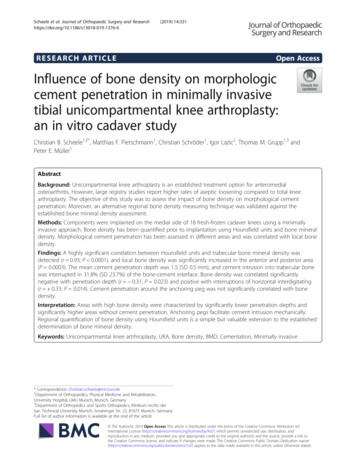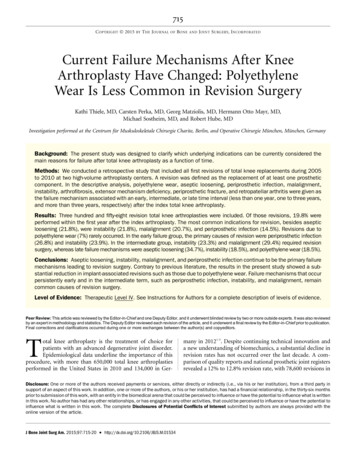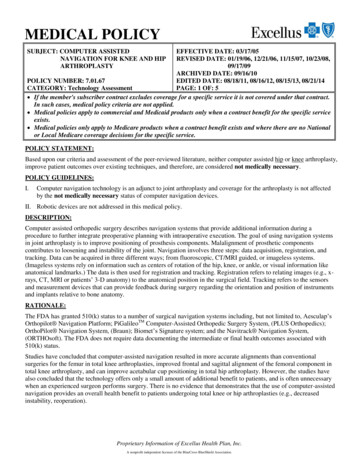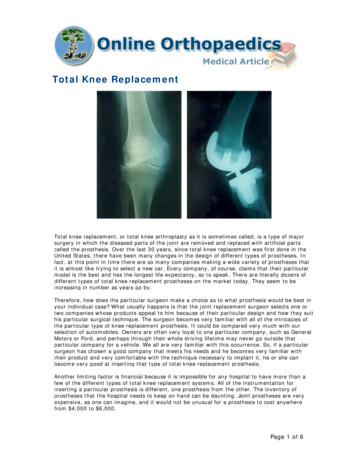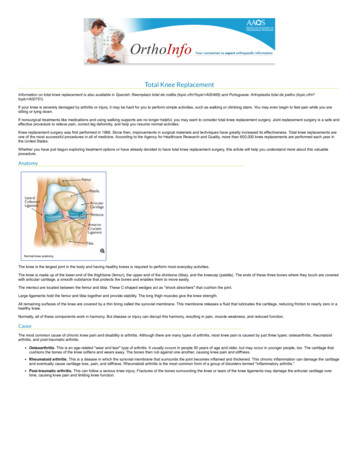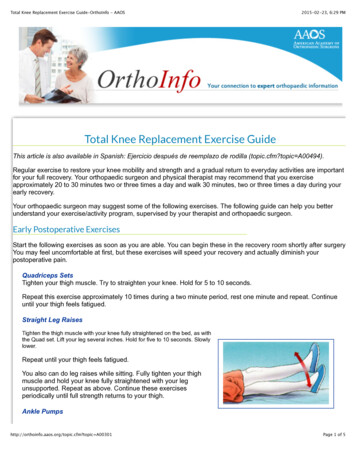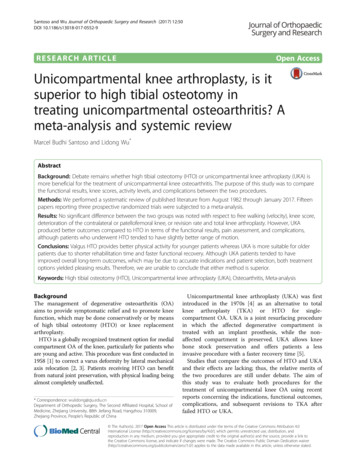
Transcription
Santoso and Wu Journal of Orthopaedic Surgery and Research (2017) 12:50DOI 10.1186/s13018-017-0552-9RESEARCH ARTICLEOpen AccessUnicompartmental knee arthroplasty, is itsuperior to high tibial osteotomy intreating unicompartmental osteoarthritis? Ameta-analysis and systemic reviewMarcel Budhi Santoso and Lidong Wu*AbstractBackground: Debate remains whether high tibial osteotomy (HTO) or unicompartmental knee arthroplasty (UKA) ismore beneficial for the treatment of unicompartmental knee osteoarthritis. The purpose of this study was to comparethe functional results, knee scores, activity levels, and complications between the two procedures.Methods: We performed a systematic review of published literature from August 1982 through January 2017. Fifteenpapers reporting three prospective randomized trials were subjected to a meta-analysis.Results: No significant difference between the two groups was noted with respect to free walking (velocity), knee score,deterioration of the contralateral or patellofemoral knee, or revision rate and total knee arthroplasty. However, UKAproduced better outcomes compared to HTO in terms of the functional results, pain assessment, and complications,although patients who underwent HTO tended to have slightly better range of motion.Conclusions: Valgus HTO provides better physical activity for younger patients whereas UKA is more suitable for olderpatients due to shorter rehabilitation time and faster functional recovery. Although UKA patients tended to haveimproved overall long-term outcomes, which may be due to accurate indications and patient selection, both treatmentoptions yielded pleasing results. Therefore, we are unable to conclude that either method is superior.Keywords: High tibial osteotomy (HTO), Unicompartmental knee arthroplasty (UKA), Osteoarthritis, Meta-analysisBackgroundThe management of degenerative osteoarthritis (OA)aims to provide symptomatic relief and to promote kneefunction, which may be done conservatively or by meansof high tibial osteotomy (HTO) or knee replacementarthroplasty.HTO is a globally recognized treatment option for medialcompartment OA of the knee, particularly for patients whoare young and active. This procedure was first conducted in1958 [1] to correct a varus deformity by lateral mechanicalaxis relocation [2, 3]. Patients receiving HTO can benefitfrom natural joint preservation, with physical loading beingalmost completely unaffected.* Correspondence: wulidong@zju.edu.cnDepartment of Orthopedic Surgery, The Second Affiliated Hospital, School ofMedicine, Zhejiang University, 88th Jiefang Road, Hangzhou 310009,Zhejiang Province, People’s Republic of ChinaUnicompartmental knee arthroplasty (UKA) was firstintroduced in the 1970s [4] as an alternative to totalknee arthroplasty (TKA) or HTO for singlecompartment OA. UKA is a joint resurfacing procedurein which the affected degenerative compartment istreated with an implant prosthesis, while the nonaffected compartment is preserved. UKA allows kneebone stock preservation and offers patients a lessinvasive procedure with a faster recovery time [5].Studies that compare the outcomes of HTO and UKAand their effects are lacking; thus, the relative merits ofthe two procedures are still under debate. The aim ofthis study was to evaluate both procedures for thetreatment of unicompartmental knee OA using recentreports concerning the indications, functional outcomes,complications, and subsequent revisions to TKA afterfailed HTO or UKA. The Author(s). 2017 Open Access This article is distributed under the terms of the Creative Commons Attribution 4.0International License (http://creativecommons.org/licenses/by/4.0/), which permits unrestricted use, distribution, andreproduction in any medium, provided you give appropriate credit to the original author(s) and the source, provide a link tothe Creative Commons license, and indicate if changes were made. The Creative Commons Public Domain Dedication o/1.0/) applies to the data made available in this article, unless otherwise stated.
Santoso and Wu Journal of Orthopaedic Surgery and Research (2017) 12:50MethodsSearch strategyThe present study was conducted using the PreferredReporting Items for Systematic Reviews and MetaAnalyses (PRISMA) statement. A computerized search ofelectronic databases (MEDLINE, Embase, and Cochrane)for English-language studies, as well as all related publishedfull studies prior to January 2017, was performed using thefollowing keywords to maximize the search sensitivity andspecificity: “high tibial osteotomy (HTO),” “unicompartmental knee arthroplasty (UKA),” “unicompartmental kneeosteoarthritis,” and “high tibial osteotomy versus unicompartmental knee arthroplasty.”Page 2 of 10cases where these conditions were not satisfied, arandom-effects model was adopted [6].The odds ratio (OR) and associated 95% confidence interval (CI) were used to determine the value of dichotomousdata. Continuous data were evaluated by means of the standardized mean difference (STD) and the corresponding95% CI values using the Mantel–Haenszel method [7].In all cases, P values 0.05 were considered statisticallysignificant. Sensitivity and subgroup analyses wereconducted to obtain a solid conclusion and to evaluatethe stability of the results. Review Manager (RevMan)version 5.3 for Windows and the Cochrane collaborationwere used to interpret the relevant variables andestablish the 95% CI.Inclusion and exclusion criteriaAll retrospective studies and prospective randomizedstudies that satisfied the search strategy were reviewedand were included in the present analysis if they met thefollowing criteria: studies comparing the outcomes ofHTO and UKA that clearly described at least one of theindices investigated in this analysis, articles published inEnglish, and cases with no previous history of knee injury. The title and abstract were examined independentlyby two reviewers. All disagreements were resolvedthrough discussion until a consensus was reached.ResultsData collectionPopulation characteristicAll information regarding participants and clinical outcomes was recorded. Participant data included thenumber of patients, age, gender, and number of kneestreated. The principle outcomes of interest includedpost-operative functional outcomes, range of motion,velocity, complications, and incidence of revision toTKA. Data were documented independently by twoauthors after the qualifying studies were selected.Overall, 1013 patients/1041 knees were treated with HTOand 5438 patients/5497 knees were treated with UKA. Patients’ age ranges were 42.7–71 years and 49.2–80 years,respectively. Only 11 studies [5, 8, 9, 12, 13, 15, 17–21]provided patients’ gender: 195 males and 277 femalesunderwent HTO, whereas 182 males and 374 femalesunderwent UKA. The follow-up period ranged from aminimum of 0.5 years to a maximum of 17 years. Eightstudies [5, 12, 13, 15, 17, 19–21] reported the indicationsfor inclusion in the study; these were strictly used forisolated medial knee OA with a varus deformity. Theinclusion criteria for the other studies were varied or unclear. Six papers [5, 12, 13, 15, 18, 20] reported the cohortsusing the Ahlbäck OA score, and three papers [9, 17, 21]used the Kellgreen–Lawrence (K/L) score. All of the included studies described the type of procedure, except one[18] in the HTO group and three [8, 16, 18] in the UKAgroup. Details are provided in Tables 1 and 2.Quality assessmentThe reliability of results depends on the extent to whichpotential sources of bias have been avoided. To adopt thesame method to evaluate all selected studies, two reviewers independently applied the “assessing risk of bias”table to assess the risk of bias in each included study. Thefollowing biases were assessed: selection bias, performancebias, attrition bias, detection bias, reporting bias, andother bias. Disagreements were resolved throughdiscussion between the reviewers.Study characteristicA total of 1723 titles and abstracts were identified usingthe search strategies described above, of which 1481were full-text publications that were then screened basedon the inclusion criteria. Thirty-nine studies comparedHTO and UKA; however, 24 studies were excluded(Fig. 1). Ultimately, 15 studies [5, 8–21] were selectedand included in our analysis, of which only 3 wereprospective randomized studies (Fig. 2).Meta-analysisStatistical analysisThe heterogeneity of this study was determined by documenting the methodological distinctions among severalstudies by analyzing the data extraction tables. The I2test was used to evaluate statistical heterogeneity; if theP value was less than 0.05 and the I2 value was less than50%, a fixed-effects model was selected. However, inBecause the measurement time points varied among studies, nearly all results reported here reflect the pooled datawithout period stratification. In addition, not all studies presented the essential data, introducing a potential bias to thisstudy. Upon analyzing statistical heterogeneity, seven outcomes showed substantial heterogeneity (I2 values 50%)and were therefore interpreted with caution (Table 3).
Santoso and Wu Journal of Orthopaedic Surgery and Research (2017) 12:50Fig. 1 PRISMA ChartThere was limited evidence of a publication bias, with abroad symmetrical funnel plot assessing the primary outcomes (excellent/good results) (Fig. 3).Primary outcomeThe analysis of 10 studies [5, 8, 9, 11–15, 18, 20] yielded astatistically significant difference between HTO and UKAregarding excellent/good results (p 0.001; OR 0.37;Page 3 of 10Fig. 2 Risk of bias assessment shown in included studies95% CI 0.24, 0.58; Fig. 4). Among them, five studies[5, 12, 13, 15, 20] provided clear support for medialOA, specifically in cases of varus deformity; however,the difference was not significant (p 0.43; OR 0.75;95% CI 0.37, 1.52). Moreover, the subgroup analysisfor the HTO group included opening [14, 15, 20] andclosing-wedge [5, 8, 9, 11–13] procedures; these
Santoso and Wu Journal of Orthopaedic Surgery and Research (2017) 12:50Page 4 of 10Table 1 Description of studies included in the meta-analysisAuthorYearType of studyTypePtsKneeM/FAge (years)HTO type/UKA modelFollow-upKarpman et al. [8]1982RetrospectiveHTO212318/357CWHTO2 yearsUKA192115/462NS3 yearsBroughton et al. [9]1986RetrospectiveHTO454911/3871CWHTO7.8 yearsUKA344211/3163St Georg5.8 yearsJefferson RJ et dIvarsson et al. [5]1991ProspectiveHTO10104/662CWHTO1 yearRandomizedUKA10104/664Oxford/PCA0.5 yearsWeale et al. [11]1994RetrospectiveHTO2121NS74CWHTO12–17 yearsUKA151580St Georg12–17 yearsStukenborg et al.2001ProspectiveHTO323219/1367CWHTO7.5 yearsRandomizedUKA28306/2267Aesculap7.5 yearsProspectiveHTO181810/863CWHTO5 years2211/1163Brigham5 yearsNSNSOWHTO2–4 years[10][12]Borjesson et al.[13]2004RandomizedUKA22Dettoni et al. [14]2008ProspectiveHTO54UKA56Accuris2–4 yearsTakeuchi et al. [15]2010RetrospectiveHTO24276/1867OWHTO5.1 yearsUKA18304/1477Nakashima7 yearsDahl-W et al. A4799Yim JH et al. [17]2012RetrospectiveHTO587/5158.3OWHTO3.6 yearsUKA50502/4860.3Miller-Galante3.7 yearsS Karamitev et 2Tuncay et al. [19]2015RetrospectiveHTO889318/7052.6OWHTO Dome3 yearsUKA9410915/7958.7Oxford3.5 yearsPetersen et al. [20]2016RetrospectiveHTO232314/958.9OWHTO5 yearsUKA25259/1660.7Oxford III5 yearsAJ Krych et al. .749.2OWHTO CWHTOMiller–Galante7.2 years5.8 years[18]Many58year year of publication, Type procedure type, Pts patients, Knee number of operated knee, M/F male/female, HTO high tibial osteotomy, UKA unicompartmentalknee arthroplasty, CWHTO close-wedge high tibial osteotomy, OWHTO open-wedge high tibial osteotomy, PCA porous coated anatomic implant, NS not statedyielded differing results, with p values of 0.49 and0.01, respectively, compared to the UKA group.(p 0.43; OR 2.24; 95% CI 0.30, 16.72), nor was thedifference for patellofemoral deterioration (p 0.21; OR 2.01; 95% CI 0.67, 6.04).Pain assessmentFive studies [5, 9, 11, 13, 18] reported post-operative results for pain assessment. Patients in the UKA grouptended to have better results. According to our analysis,the difference was significant (p 0.03; OR 0.34; 95%CI 0.13, 0.91).Range of motion (ROM)DeteriorationFree walking speed (velocity)Based on the available data, only two studies [9, 17]included information on deterioration. However, the difference for contralateral deterioration was not significantOnly three studies [5, 10, 13] compared the free walkingspeed between HTO and UKA patients; these showedno significant difference (p 0.66; STD 0.09; 95%Our analysis revealed better flexion and extended ROM inthe HTO group compared to the UKA group in five studies[5, 12, 13, 15, 17], with p values 0.01 (STD 0.78;95% CI 0.21, 1.36).
Santoso and Wu Journal of Orthopaedic Surgery and Research (2017) 12:50Page 5 of 10Table 2 Summary of data recorded from studies included in meta-analysisAuthorType PtsKnee E/GPainRevision Complication Kneeresults no/mild TKAScoreROMVelocityFTAKarpman et al. [8]HTO212311NSNSNSNSNSUKA192119Broughton et al. [9] HTO454921Baily35.8 7NSNSNSNS1.02 0.19 NSNS23011231017UKA3442323434Jefferson RJ et al.HTO2023NSNS5NSNS39.6 7.3[10]UKA2024Ivarsson et al. [5]HTO1010410NSNSLysholm 78 19UKA1010810Weale et al. [11]HTO21217917NSBailyUKA15158125Stukenborg et al.HTO323215NS109KSS[12]62NSNSBOANSKSSKSSNS170.99 0.21 ( ) 3.2 91 11112 130.93 0.22NSNS76 (29–100) 117 (85–135) NS( ) 0.25 74 (31–94)103 (35–140)( ) 5.25 37 (36–39)123 0.51.13 0.14 NS37 (31–39)123 0.51.19 0.15NSNSNSNS89 7.6146 5.9NS170 2.1 79 6.8127 16NSNSNSNS138.8 4.7NS( ) 1.8 1.7 2830131818181822222250NS0NS022376NSNSLysholm 89.6 8.722HTO54UKA56Takeuchi et al. [15]HTO242727UKA183029HTO450Dahl-W et al. [16]530174 3.8 NSNSNSNS390.3 7.7130.0 NSNS( ) 1.3 2.4 UKA4799HTO58UKA5050S Karamitev et al.HTO92968378[18]UKA65666556Tuncay et al. NSUKA183 183AJ Krych et al. [21]NSNSYim JH et al. [17]Petersen et al. [20]NS34UKAUKA0.94 0.30 NS31Borjesson et al. [13] HTODettoni et al. [14]121 11816583NS( ) 1.9 2.2 90HSSNSLysholm 80.2 11.81190.0 11.0NSType procedure type, Pts patients, Knee number of operated knee, E/G excellent, good result, Pain pain assessment, ROM range of motion, Velocity free walkingspeed, FTA femoro-tibial angle, Baily Baily knee score, Lysholm Lysholm knee score, KSS Knee Society score, BOA British Orthopaedic Association score, HSS Hospitalfor Special Surgery score, ( ) valgus, ( ) varus, NS not statedCI 0.48, 0.30).Knee scoreSeven studies [5, 12, 13, 15, 17, 19, 21] used various scoring systems to compare knee scores between the twoprocedures. Although no statistically significant differencewas found (p 0.11; STD 0.21; 95% CI 0.47, 0.05),the UKA group exhibited better functional results. Ourstudy also analyzed the Lysholm knee score [5, 17, 21] andKnee society score (KSS) [12, 15], which showed no significant differences (p 0.08 and 0.59, respectively).ComplicationGenerally, more complication were noted after a valgusHTO with significant difference found between the twogroups (p 0.001; OR 3.08; 95% CI 1.76, 5.39), reflecting results from seven studies [8, 9, 12, 15, 17, 19, 20]with 559 patients.RevisionEleven studies [8–12, 14–16, 19–21] with 6241 patients reported revisions. The pooled data showed nosignificant difference between HTO and UKA interms of revision rate (p 0.68; OR 1.18; 95% CI 0.54, 2.58; Fig. 5).
Santoso and Wu Journal of Orthopaedic Surgery and Research (2017) 12:50Page 6 of 10Table 3 Result of the meta-analysisOutcomeStudiesSample sizeEffect estimateHTOUKAOdds ratio (95% CI)PEffect estimateHeterogeneitySTD (95% CI)I2 (%)Chi2 (P)Pain assesment (no/mild)51941550.34 [0.13, 0.91]0.03610.08Excellent/good (E/G) result103533170.37 [0.24, 0.58] 0.00001390.11Excellent/good result (medial OA/varus)51101170.75 [0.37, 1.52]0.43190.29Subgroup: E/G CWHTO-UKA61531400.36 [0.21, 0.61]0.01560.06Subgroup: E/G OWHTO-UKA31041110.70 [0.26, 1.91]0.4900.66Knee score72623170.11 0.21 [ 0.47, 0.05]510.05Lysholm knee score3921260.08 0.53 [ 1.12, 0.06]710.030.590.10 [ 0.26, 0.46]Knee Society Score (KSS)25960Deterioration of contralateral2107922.24 [0.30, 16.72]0.43Deterioration of patellofemoral2107922.01 [0.67, 6.04]0.21ROM514514200.88740.0500.570.0080.78 [0.21, 1.36]800.00050.66 0.09 [ 0.48, 0.30]Velocity3515100.44Complication73053073.08 [1.76, 5.39] 0.000170.37Revision rate1188053611.18 [0.54, 2.58]0.6874 0.0001HTO high tibial osteotomy, UKA unicompartmental knee arthroplasty, P p value, E/G excellent, good result, OA osteoarthritis, Varus varus deformity, STD Std meandifference, CI confidence intervalDiscussionOA affects any or all three compartments of the knee.However, one third of patients are afflicted in only oneof these compartments, many of them having a medialcompartment disorder [22].The purpose of surgery for unicompartment OA is toreduce pain, restore function, and improve the patient’squality of life. The most important finding of this studywas that both HTO and UKA are satisfactory operativetreatment options for symptomatic medial knee OA.Patient selection is generally stricter for individualsundergoing HTO than for those receiving UKA. However, medial knee arthritis patients selected for HTOFig. 3 Funnel plot to assess small study exclusion/publication biasexperience many benefits. Ideal indications for HTOinclude (1) young and active patients (age 65 years)[23, 24], (2) normal-range body mass index (BMI) [25],(3) mild articular destruction (no more than grade 2Ahlbäck classification), (4) no patellofemoral arthrosis[26], and (5) good ROM and a stable joint [27].Age, BMI, and pre-operative state OA are key factorsthat optimize clinical outcomes and survival in patientsundergoing HTO. Previous studies have reported that apre-operative BMI higher than 27.5 is a significant riskfactor for early failure [25], and patients with BMI over30 exhibit significantly lower KSS and WOMAC scores5 years after HTO [28]. Moreover, HTO is not advisable
Santoso and Wu Journal of Orthopaedic Surgery and Research (2017) 12:50Page 7 of 10Fig. 4 Forrest plot of ten studies presenting data about primary outcome (excellent/good) resultfor patients older than 65 years due to the 7.6% increased risk per year of age and the 1.5-fold relative riskof failure compared to younger patients [29].HTO and UKA share similar indications that includethe following: age 55–65 years, moderately active, nonobese, presenting with mild varus malalignment andmoderate unicompartmental arthrosis, no joint instability, and good ROM [30].Indications for UKA are broadening after reports ofpromising mid- and long-term results, which include isolated medial or lateral compartment OA, osteonecrosis ofthe knee, age over 60 years, weight under 82 kg, and anideal ROM of 90 with fewer than 5 flexion contractures.Contraindications include high activity, age under 60 years,and inflammatory arthritis [11, 30, 31].Our analysis demonstrated a significant difference inoutcomes between UKA and HTO patients, with theformer showing better functional results (excellent/goodresults), and the latter better ROM. This discrepancyFig. 5 Forrest plot of ten studies presenting data about revision ratewas correlated with knee score and ROM, indicating thepossibility of additional impacts on the functionalresults.Earlier publications reported a valgus deformity treatedwith either procedure. In our opinion, the clinical resultsfor patients with a surgically treated valgus deformity, byeither arthroplasty or osteotomy, cannot be compared toresults for patients with a varus deformity. Major differences between medial and lateral UKA, as well as betweenvarus and valgus osteotomy have been noted [4, 9, 32–34].Therefore, our analysis showing excellent/good functionalresults focused only on studies with a strict inclusion criterion of medial knee OA with a varus deformity; analysisof such cases showed no significant difference betweenthe two procedures. The subgroup analysis yielded similarfindings and revealed favorable results in the UKA grouprelative to closed-wedge HTO (CWHTO) patients;however, these results were not noted when comparingopen-wedge HTO (OWHTO) and UKA. CWHTO was
Santoso and Wu Journal of Orthopaedic Surgery and Research (2017) 12:50the main treatment method for HTO in the past, butOWHTO was recently reported to yield good or excellentresults, owing to improvements in surgical techniques andimplant stability [35, 36]. However, recent meta-analysescomparing CWHTO and OWHTO did not report superiority of OWHTO over CWHTO [37, 38].A greater change in ROM was noted in the UKAgroup relative to the HTO group due to a lower preoperative score [5]. Takeuchi et al. [15] reported thatOWHTO is a more appropriate treatment method foractive patients who require good ROM of the knee. Theunsatisfactory results of the HTO group were mostlydue to an insufficient deformity correction. Previousstudies reported that optimal results can be achieved ifthe mechanical alignment is adjusted to 7 [39]. Nevertheless, the ultimate post-operative valgus position istechnically challenging to achieve.Free walking speed (velocity) has been proven both areliable and a valid indicator to evaluate treatment outcomes in knee OA patients [40, 41]. Our meta-analysisfound no significant difference between the two procedures in terms of velocity (p 0.66), although Fu et al.[42] reported otherwise (p 0.05). However, given thatboth studies used the same literature to arrive at thisoutcome, differing results were not expected. It is alsoimportant to note that Jefferson et al. [10] assessed thevelocity outcome of three operative methods (HTO,UKA, and TKA), with post-operative results reported as1.02 0.19, 0.99 0.21, and 0.81 0.19 m/s, respectively.However, Fu et al. [42] included the TKA results (0.81 0.19) in their analysis of the HTO group, which maysuggest an inaccuracy. Therefore, our results are moreaccurate and reliable.Our analysis revealed that free walking speed was improved after both HTO and UKA but with an equivalentrise in the UKA group. Borjesson et al. [13] stated that,compared to HTO patients, UKA patients had a greaterincrease in free walking speed, with results 5 years aftersurgery that were highly similar to the walking speed ofhealthy people of the same age group [43]. Moreover,both procedures resulted in an almost normal gaitpattern.Ivarsson et al. [5] showed that UKA patients have bettermuscle strength than do HTO patients 6 months postoperatively, but the 12-month post-operative results weresimilar. One explanation for this finding is that rehabilitation of UKA patients normally begins earlier, whereasHTO patients usually undergo an immobilization period.Moreover, HTO patients may require a longer time toadapt due to greater changes in post-surgical legalignment.Regarding the progression of knee OA, our analysisshowed that the OR of the risk of contralateral and patellofemoral deterioration did not differ between groups,Page 8 of 10although the HTO group tended to exhibit this problem.One logical explanation is that this phenomenon is due tothe overcorrection to unleash the medial compartmentduring the procedure, thus suppressing the lateral compartment and leading to deterioration. Overcorrection ofmore than 6 was associated with progressive degenerationof the lateral compartment [44]. In addition, OWHTOabove the tibial tubercle can have adverse effects on patellofemoral articulation [2, 45, 46]. Yim et al. [17] comparedOWHTO and UKA patients and reported that two casesof UKA showed patellofemoral joint OA compared tothree cases of OWHTO.Compared to UKA, the chance of post-operative complications is greater after an osteotomy [39]. Our analysisrevealed a significant difference in such complicationsbetween HTO and UKA patients, supporting previousstudies and a meta-analysis by Spahn et al. [47]. Amongall included studies in this present study, five trialsapplied OWHTO, seven trials used CWHTO, and onestudy used hemicallotasis. OWHTO is considered safeand easy [21, 48, 49] based on the assumption thatCWHTO may be associated with a higher incidence ofcomplications, especially peroneal nerve paralysis. Despite improved surgical techniques and implant design,previous studies have reported complications after UKA,such as loosening of the tibial or femoral component orosteoarthritic changes in the development of the lateralcompartment due to antero–posterior instability of theknee, which leads to rapid wearing of the polyethyleneinsert [11, 21]. In the HTO group, most complicationswere associated with an intra-articular fracture,nonunion, infection, and peroneal nerve palsy.TKA is defined as a clear end-point after both HTOand UKA. Medial UKA patients tend to require revisionsooner [21], with a mean of 8.2 years compared to amean of 9.7 years for valgus HTO patients [47]. Barrettand Scott [50] reported 29 unsuccessful UKA revisionsto TKA and observed that the mechanism of failure wasloosening in 55% of cases and degeneration advancement of the remaining compartments in 31% of patients.Technical errors during the primary UKA and poorselection of patients contributed to 66% of failures.Cross et al. [51] examined the operative time andfound that revision to TKA in HTO patients requiredmore time compared to that for UKA patients, whichcould be because the HTO procedure is complicated bydifficulties in obtaining an acceptable exposure, removing retained hardware, achieving correct tibial component positioning, scarring, and additional challengeswith ligamentous balancing that have been reported toresult from a prior HTO. The major technical difficultyin the revision UKA group was handling the bony defects on both the tibial and femoral sides. Significantlythicker polyethylene inlays were required during the
Santoso and Wu Journal of Orthopaedic Surgery and Research (2017) 12:50revision of UKA to TKA compared to primary TKA[52], and the UKA group required substantially more osseous reconstruction (77%) compared to the HTO group(20%) [30].Consistent with the previous meta-analysis [42], thepresent study also failed to identify any significant difference in the revision rate between the two procedures.Although both groups exhibited higher revision rates overtime with deteriorated clinical outcomes, the risk ofrevision of primary UKA declined with age. The 10-yearrevision rate was nearly 24% in patients aged less than55 years, threefold higher than that in those aged 55 yearsand older [16].Robertsson et al. [53] reported that hospitals that perform 23 or more UKAs per year have a 1.6-fold lowerrevision rate compared to those who perform fewer than23. Therefore, routine patient selection and good surgical skills are believed to influence the results of the UKAprocedure; this principle may also apply to HTO.Several limitations of this study should be noted. First, acontrolled randomized trial is challenging due to ethicalconcerns. The present meta-analysis included only threerandomized controlled trials of the 15 studies and the patients enrolled for HTO tended to be younger than thoseenrolled for UKA. Although most studies reported goodnumbers, the use of diverse analyzing systems andmethods can lead to difficulties comparing and assemblingthe outcomes, as well as inability to evaluate essentialitems such as radiographic changes due to inadequatedata. Moreover, the current analysis showed that UKAand HTO are distinct in terms of their techniques and indications for patients with medial unicompartmental OA.Finally, the small patient population made it difficult tocompare the two procedures and arrive at a conclusionregarding the clinical outcomes.ConclusionsIn conclusion, valgus HTO is a technically challengingprocedure but provides younger OA patients with goodphysical activity. On the other hand, UKA is more suitable for older patients, as it provides a greater quality oflife with a shorter rehabilitation time required before fullweight bearing, fewer perioperative complications, andfaster functional recovery compared to HTO.Accurate identification of indications, including age,level of activity, grade of OA and ROM of the knee, andcareful patient selection are essential for all OA patients.Nevertheless, with advancements in surgical techniques,implant design and patient selection, UKA has become amore reliable and effective procedure.Finally, although UKA patients tended to have improvedoverall long-term outcomes, both treatment optionsoffered pleasing results, and no significant evidencesupports one method over the other. Additional well-Page 9 of 10designed and large-scale clinical trials and systematicreviews are necessary to confirm the findings presentedhere.AbbreviationsBMI: Body mass index; CI: Confidence interval; CWHTO: Closing-wedge hightibial osteotomy; HTO: High tibial osteotomy; KSS: Knee society score;OA: Osteoarthritis; OR: Odds ratio; OWHTO: Opening-wedge high tibialosteotomy; ROM: Range of motion; STD: Standardized mean difference;TKA: Total knee arthroplasty; UKA: Unicompartmental knee arthroplastyAcknowledgementsThis study was supported by the Department of Orthopedic Surgery of theSecond Affiliated Hospital of Zhejiang University for their assistance inobtaining the texts, which formed the basis of this meta-analysis.FundingNo funding source was involved in the conduction of this study.Availability of data and materialThe dataset(s) supporting the conclusions of this article are included withinthe article.Authors’ contributionsMBS and LDW are both con
Unicompartmental knee arthroplasty (UKA) was first introduced in the 1970s [4] as an alternative to total knee arthroplasty (TKA) or HTO for single-compartment OA. UKA is a joint resurfacing procedure in which the affected degenerative compartment is treated with an implant prosthesis, while the non-affected compartment is preserved. UKA allows .


